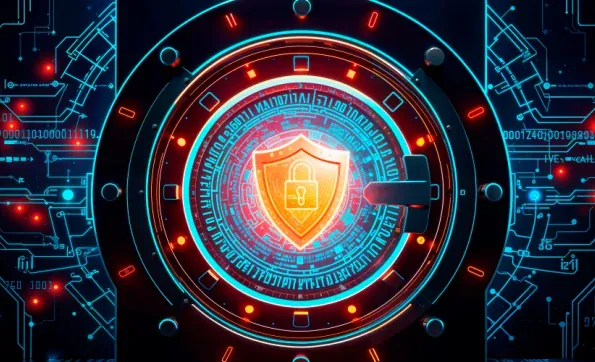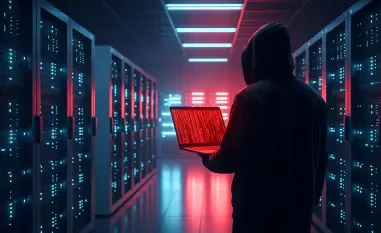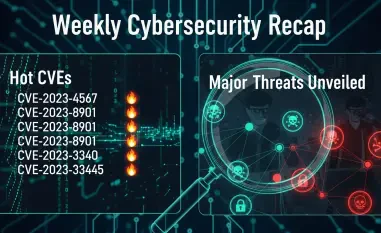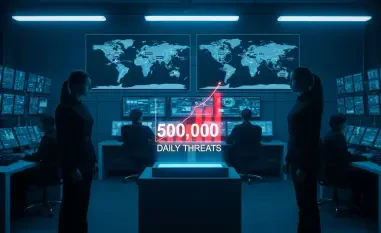The continuous evolution of cybersecurity presents a critical challenge in protecting data and infrastructure from increasingly sophisticated cyber threats. These threats are powered largely by advancements in artificial intelligence (AI) and automation. As cybercriminals gain access to more advanced technology, traditional security measures are becoming insufficient, leading to a pressing need for innovative solutions. This article explores the various dimensions of cybersecurity’s future, focusing on innovation, leadership, and emerging threats.
AI-Powered Cyber Threats
The Rise of AI-Driven Attacks
AI technology has armed cybercriminals with the ability to generate highly sophisticated and convincing cyber threats. This advancement in AI enables criminals to create deepfake scams that mimic executives or high-profile individuals with uncanny accuracy. Consequently, these scams have become more prevalent and challenging to detect. Additionally, AI has elevated ransomware attacks to new levels of complexity and efficiency, devastating vital infrastructure such as hospitals, banks, and government systems.
In an alarming demonstration of AI’s potential misuse, cybercriminals can now launch thousands of automated attacks within minutes. The speed and precision with which these AI-driven attacks are executed exemplify the profound danger of combining malicious intent with advanced technology. This proliferation of AI-enhanced threats underscores the urgent need for comprehensive, sophisticated defenses capable of neutralizing these threats in real-time.
The Need for AI-Driven Defenses
As AI-driven threats become increasingly prevalent and damaging, the necessity for equally advanced AI-driven defenses becomes more apparent. Traditional cybersecurity measures are no longer sufficient to safeguard against the rapid evolution of cyber threats. This paradigm shift mandates that defenders leverage advances in AI technology to proactively identify and neutralize threats, thereby staying ahead of cybercriminals.
In this AI-versus-AI battlefield, the ability to deploy advanced mechanisms to counter sophisticated threats effectively is crucial. AI can be employed to analyze vast quantities of data, detect anomalies, and respond to threats instantaneously. This proactive approach to cybersecurity not only enhances the ability to thwart attacks but also reduces the response time, mitigating potential damage and ensuring the security and integrity of critical systems and data.
Economic Impact of Cyber Breaches
Financial Repercussions of Cyberattacks
The financial repercussions of cyberattacks are substantial and growing. With the global average cost of a data breach projected to rise to $4.88 million by 2024, the economic strain on businesses worldwide is significant. This trend underscores the critical necessity for robust and dynamic cybersecurity measures to prevent these potentially crippling financial losses. Beyond direct costs, breaches can lead to long-term reputational damage, loss of customer trust, and legal ramifications, all of which have far-reaching consequences for organizations.
Cyberattacks target businesses of all sizes across various industries, making no one immune from potential devastation. Small and medium-sized enterprises (SMEs), often with limited resources, can find it particularly challenging to recover from such incidents. Therefore, it is imperative for organizations to invest in state-of-the-art cybersecurity solutions that can adapt and respond to evolving threats, ensuring the protection of their digital assets and financial stability.
Evolving Attack Vectors
Sophos, a leading cybersecurity firm, highlights the continuing evolution of attack vectors, which offer cyber gangs more opportunities to execute sophisticated and financially damaging attacks. These evolving threat landscapes include advanced phishing methods, zero-day exploits, and multi-vector attacks that combine different techniques to breach security defenses. The constant adaptation and innovation by cybercriminals necessitate that cybersecurity strategies be equally dynamic and innovative to counter these threats effectively.
Organizations must remain vigilant and continuously update their security measures to keep pace with the ever-changing attack vectors. This involves implementing comprehensive threat intelligence programs, conducting regular security assessments, and incorporating advanced threat detection technologies that can anticipate and mitigate potential attacks before they occur. By staying ahead of the curve and embracing a proactive approach to cybersecurity, businesses can better protect themselves against the detrimental financial impacts of cyber breaches.
Crisis-Driven Innovation
Historical Incidents as Catalysts
Historical cybersecurity crises have been pivotal in driving innovation within the industry. The 2013 Target breach, which exposed the credit card details of 40 million customers, served as a wake-up call for businesses worldwide. This incident accelerated the adoption of zero trust frameworks, a security model that assumes all network traffic is potentially malicious and continuously verifies the trustworthiness of each user and device. Similarly, the revelations by Edward Snowden regarding government surveillance in 2013 highlighted the urgent need for end-to-end encryption to protect sensitive data from unauthorized access.
Moreover, the 2017 WannaCry ransomware attack, which spread across 150 countries in just 24 hours, exploited vulnerabilities in outdated software systems. This incident underscored the critical importance of abandoning legacy systems and investing in AI-driven threat detection technologies that can adapt to the rapidly evolving threat landscape. These historical incidents catalyzed significant changes in cybersecurity practices, compelling organizations to rethink their security strategies and invest in advanced technologies to bolster their defenses.
Recent Cybersecurity Crises
More recent cybersecurity crises have revealed new vulnerabilities and prompted further innovation in the field. The SolarWinds attack in 2020, which compromised numerous high-profile government and private sector organizations, exposed critical weaknesses in supply chain security. Similarly, the 2021 Colonial Pipeline ransomware event disrupted fuel supply chains across the Eastern United States, highlighting the vulnerabilities in critical infrastructure.
These incidents have forced governments and corporations to reconsider their security strategies for essential infrastructure. In response, organizations are now prioritizing the implementation of advanced threat detection technologies, comprehensive risk assessment processes, and robust incident response plans to mitigate the impact of such attacks. These crisis-driven innovations aim to enhance the overall resilience and security of vital systems and infrastructure, ensuring that they can withstand future cyber threats.
Importance of Leadership and External Forces
Leadership as a Driver of Innovation
Leadership is a fundamental driver of cybersecurity innovation. Strong leadership can cultivate a culture of security within an organization, promoting internal initiatives that lead to significant advancements. By prioritizing cybersecurity at the highest levels, leaders can allocate appropriate resources, set clear security goals, and foster an environment that encourages innovation and proactive defense strategies. Effective leaders recognize the importance of staying ahead of emerging threats and continuously pushing the boundaries of traditional security models.
The urgency to defend against increasingly sophisticated attacks and the influence of external forces, such as market conditions and regulatory requirements, further push organizations to innovate. Leaders must navigate these complexities and drive the adoption of cutting-edge technologies and best practices to protect their organizations from cyber threats. By embracing a forward-thinking approach and fostering a culture of continuous improvement, leaders can ensure that their organizations remain resilient and secure in the face of evolving cyber threats.
Market Dynamics and Security Solutions
Cybersecurity experts emphasize that the next significant solution in the field cannot simply be summoned on demand. Instead, innovation requires a conducive environment characterized by proactive leadership, a pressing need to counter threats, and favorable market dynamics. The interplay between these factors creates a fertile ground for the development and adoption of advanced security solutions that can effectively address the challenges posed by modern cyber threats.
Market dynamics, driven by economic conditions and competitive pressures, play a crucial role in shaping cybersecurity investments and innovation. During periods of economic prosperity, increased funding for cybersecurity startups and research leads to the development of groundbreaking technologies and solutions. Conversely, economic downturns can result in budget cuts, leaving organizations more vulnerable to attacks. Therefore, it is essential for leaders to recognize the impact of market conditions and make strategic investments in cybersecurity to ensure their organizations remain protected and resilient.
Economic Influences on Cybersecurity
Investment Trends and Economic Cycles
The state of the economy plays a substantial role in shaping cybersecurity investments. During times of economic prosperity, funding for cybersecurity startups and research surges, leading to groundbreaking technologies and solutions. This influx of capital allows for the development of advanced threat detection systems, AI-driven defenses, and other innovative security measures that enhance the overall resilience of organizations. Conversely, economic downturns often result in budget cuts to cybersecurity spending, leaving organizations vulnerable to attacks due to outdated systems and inadequate defenses.
Historical examples highlight how economic conditions drive cybersecurity innovation. The adoption of zero trust frameworks following the Target breach and the rise of cloud-based security solutions post-2008 financial crisis demonstrate the correlation between economic cycles and security advancements. The COVID-19 pandemic further accelerated this trend, compelling organizations to invest heavily in securing remote work environments and bolstering their cybersecurity posture to address the challenges of a distributed workforce.
Historical Economic Impacts
The economic impact of cybersecurity investments is evident through various historical events. The adoption of zero trust frameworks following the 2013 Target breach marked a significant shift in security practices, driven by the need to address vulnerabilities exposed by the incident. Similarly, the 2008 financial crisis led to a rise in cloud-based security solutions, as organizations sought cost-effective and scalable alternatives to traditional on-premises security systems.
The COVID-19 pandemic serves as another critical point of inflection in the history of cybersecurity. The massive shift to remote work necessitated significant investments in endpoint security, virtual private networks (VPNs), and zero trust models to protect against the increased threat landscape. As a result, cybersecurity spending reached unprecedented levels, driving innovation and the development of advanced security solutions. However, the recent rise in interest rates and shifting venture capital priorities have slowed startup funding, leading to mergers and acquisitions instead of fresh innovation.
Corporate Leadership and Open Innovation
Corporate Initiatives in Cybersecurity
Large corporations have played a significant role in driving cybersecurity advancements. Initiatives such as Google’s 20% Rule, which allowed engineers to dedicate a portion of their time to experimental projects, led to significant security breakthroughs. Similarly, Microsoft’s Secure Future Initiative, which mobilized over 34,000 engineers, fundamentally overhauled its security framework and set new industry standards. These corporate policies and extensive resources have facilitated the development of innovative security solutions that enhance the overall resilience of organizations.
Corporate initiatives are not limited to internal projects; they also encompass collaborations with other industry players, academic institutions, and government agencies. By fostering a collaborative approach, large corporations can pool resources and expertise to address common security challenges and develop comprehensive solutions that benefit the broader industry. This collaborative spirit is essential in the fight against cyber threats, as it enables the sharing of knowledge, tools, and best practices.
Open-Source Contributions
Beyond corporate initiatives, the open-source movement has been transformative in the field of cybersecurity. Open-source projects like Metasploit and DNSharmony have enabled security researchers to collaborate and share advanced tools, strengthening defenses across various industries. By providing free and accessible security tools, the open-source community has democratized access to cutting-edge technologies and fostered a culture of collaboration and innovation.
However, this open collaboration carries inherent risks, such as supply chain attacks. Malicious actors can exploit vulnerabilities in widely-used open-source software to infiltrate systems and propagate attacks across multiple organizations. Prominent examples include the Log4j vulnerability and the SolarWinds breach, which demonstrated the potential for widespread impact when supply chain attacks target critical software components. To mitigate these risks, organizations must implement robust security protocols and conduct thorough assessments of their software supply chain to ensure the integrity of their systems.
Human Error and Workforce Shortages
The Role of Human Error
Despite technological advancements, human error remains a predominant factor in security breaches. ProofPoint’s study indicates that 88% of breaches are caused by mistakes, such as misconfigured servers or falling for phishing emails. These errors highlight the critical importance of addressing the human element in cybersecurity, as even the most advanced technologies cannot fully protect against mistakes made by employees.
Organizations must invest in comprehensive security training and awareness programs to mitigate the risk of human error. By educating employees about the latest threats, best practices, and security protocols, organizations can reduce the likelihood of breaches caused by mistakes. Regular training sessions, simulated phishing exercises, and clear communication of security policies are essential components of an effective employee awareness program.
Addressing Workforce Gaps
Compounding the issue of human error is the acute shortage of cybersecurity professionals. With the workforce gap projected to reach 3.5 million unfilled positions by 2025, organizations are turning to AI-driven automation and low-code security solutions to bridge the gap. These approaches enable non-experts to participate in security efforts and streamline processes, partially alleviating the skills shortage and ensuring that critical security tasks are performed effectively.
To address the workforce gaps, organizations must also invest in initiatives aimed at attracting and retaining cybersecurity talent. This includes offering competitive salaries, opportunities for professional development, and fostering a supportive work environment that values diversity and inclusion. Collaboration with educational institutions to develop tailored training programs and certifications can also help bridge the skills gap and ensure a steady pipeline of qualified cybersecurity professionals.
Conclusion
The ongoing evolution of cybersecurity presents a significant challenge in safeguarding data and infrastructure against ever-more sophisticated cyber threats. These threats are increasingly driven by advancements in artificial intelligence (AI) and automation, which enable cybercriminals to deploy more advanced and effective attacks. As bad actors gain access to advanced technologies, traditional security measures often fall short, creating an urgent need for innovative cybersecurity solutions.
To address this growing concern, it’s essential to explore the future dimensions of cybersecurity, which include innovation, leadership, and the identification of emerging threats. Innovation is necessary to develop cutting-edge technologies and strategies that can stay a step ahead of cybercriminals. Leadership plays a critical role in fostering a culture of awareness and resilience within organizations, encouraging proactive measures and continual improvement in security practices.
Lastly, understanding emerging threats helps prepare and defend against potential risks before they become crises. As cyber threats evolve, so too must our approaches to combating them. By focusing on these key areas, we can work towards creating a more secure digital landscape, capable of withstanding the challenges posed by increasingly intelligent and automated cyber threats.













